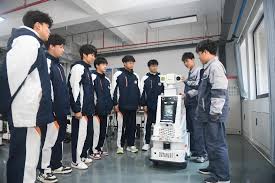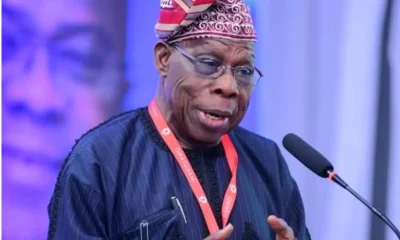Foreign
China-U.S. cooperation contributes to rapid development of Port of Los Angeles

By Chen Yiming, Shi Yuanhao, People’s Daily
Along the west coast of the U.S., the Port of Los Angeles is a hive of activity, with massive container ships constantly coming and going.
Mark Wheeler, 70, retired 4 years ago from his position as vice president of the West Basin Container Terminal (WBCT) at the Port of Los Angeles. Although he now lives in South Carolina, Mark still cares deeply about the port where he worked for decades. Whenever he talks about his career, one exciting scene always comes to mind – a visit to the port by Xi Jinping, who serves as the Chinese President today.
It was on Feb. 16, 2012. Xi, then vice president of China, had a tour to a terminal of China’s shipping giant COSCO at the Port of Los Angeles. According to Wheeler, he was serving as the terminal operations manager back then and witnessed a story of mutual benefit and win-win cooperation between the U.S. and China.
Wheeler said he never thought that a leader of a major country could be so approachable, adding that Xi shook hands with everyone and waved enthusiastically to crew members on cargo ships. It was like meeting an old friend, he noted.
The Port of Los Angeles is the largest container port in the United States and serves as the first stop for Chinese goods entering the United States across the Pacific Ocean.
In 2001, a COSCO subsidiary became a shareholder of the port, holding partial equity stakes in the WBCT at the Port of Los Angeles and the Pacific Container Terminal at the Port of Long Beach. This marked the beginning of rapid development for the Port of Los Angeles.
By 2012, the WBCT’s annual container throughput reached 1.5 million twenty-foot equivalent units (TEUs), accounting for 10 percent of the total at the Port of Los Angeles and contributing $100 million in direct tax revenue to the federal and local governments.
Since 2012, COSCO has always adhered to the principles of practical cooperation and mutual benefit in serving the trade sector, and continuously expanded its shipping routes, capital investment, and technological input in the entire Los Angeles.
For many years, the Port of Los Angeles has played an important role in U.S.-China trade, said Wheeler, attributing the development of ports in the Los Angeles area to mutually beneficial cooperation between the two countries.
So far, COSCO has directly created about 2,400 jobs in the United States. Through partnerships with trucking companies, railways, tugboat services and other suppliers, COSCO’s terminals have generated around 15,000 additional jobs in the country.
“COSCO actively promotes local economic and social development at the Ports of Los Angeles and Long Beach, striving to meet customers’ transportation needs. Especially when supply chains get tight, we strive to tackle problems like insufficient capacity and port congestion,” said Gu Quanlin, vice president of COSCO SHIPPING (North America).
According to Gu, during the peak of the COVID-19 pandemic in the United States, COSCO terminals in the country utilized multimodal transportation to swiftly deliver essential medical supplies to customers in the Midwest through the Port of Long Beach. This made a significant contribution to the local population’s response to the pandemic.
Additionally, COSCO Shipping has strengthened management around ship speed reduction, shore power usage, near-shore emissions, and equipment emissions. This aligns fully with the Californian government’s long-standing promotion of green principles.
Among all the terminals at the Ports of Los Angeles and Long Beach, COSCO terminals have always been at the forefront of protecting the ocean environment and marine life, said Paul Nazzaro, executive vice president of COSCO SHIPPING (North America).
The 130-km long Santa Barbara Channel by the Port of Long Beach is a major shipping lane, as well as one of the world’s most important destinations for migrating blue whales. It is visited by many blue whales, humpback whales and fin whales from July to November each year. Excessive ship speeds would severely impact the whales.
Since 2018, COSCO has actively implemented the project of Protecting Blue Whales and Blue Skies. So far, it has carried out relevant eco-friendly operations on 111 voyages, making effective safety nets for marine life and lowering greenhouse gas and suspended particulate emissions.
From 2020 to 2022, COSCO won the top award of the “Protecting Blue Whales and Blue Skies” project, the “Sapphire Prize,” given by the U.S. National Oceanic and Atmospheric Administration for three consecutive years.
Brian Peck, Chair of the Los Angeles Regional Export Council, stated that China is California’s largest trading partner, and one-third of U.S.-China trade passes through the Ports of Los Angeles and Long Beach. California attracts more Chinese investment than any other U.S. state and is home to the largest population of Chinese students and visitors. The close ties between California and China reflect the intertwined interests of the United States and China and demonstrate the mutually beneficial essence of U.S.-China economic and trade cooperation.
Wheeler told People’s Daily that he sincerely hopes that the two largest economies, the United States and China, can find more common ground and write more stories of cooperation and win-win outcomes through exchanges and dialogues.
Foreign
Judge blocks Trump from deporting non-citizens using wartime law

A federal judge has temporarily halted the Trump administration’s attempt to deport migrants allegedly linked to the Venezuelan gang Tren de Aragua under a wartime law.
US District Judge James Boasberg issued a restraining order preventing the administration from using the Alien Enemies Act of 1798 to expel undocumented migrants accused of gang ties. The order initially protected five individuals challenging the deportation but was later expanded to all affected noncitizens in US custody.
Boasberg also directed that any planes carrying these migrants be returned to the United States. “Any plane containing these folks that is going to take off or is in the air needs to be returned,” he ruled. The restraining order will remain in effect for 14 days or until further court action.
The Trump administration invoked the Alien Enemies Act, citing Tren de Aragua as a terrorist organization that has “unlawfully infiltrated the United States” and is engaging in hostile actions. However, civil rights groups, including the ACLU, argue that the gang’s activities do not meet the legal definition of an invasion.
The Justice Department has appealed the ruling, while the case continues in court.
Foreign
China’s new chapter in global innovation

By Gu Yekai, Liu Yiqing, People’s Daily
At a smart construction project site managed by China State Construction Engineering Corporation, a quiet technological revolution is underway. Amid cranes and concrete, engineers are deploying advanced artificial intelligence (AI) systems that could fundamentally reshape the construction industry.
Li Fengjian, an AI specialistwith Xianyuan Technology, detailed how the company’s latest intelligent system – built on a large model – adapts to complex construction environments.”Engineering machinery equipped with intelligent agents can adjust its operations automatically in response to weather conditions,” Li explained, adding that a spatiotemporal sensing network further enhances the system, providing real-time tracking of both personnel and materials throughout the construction site.
In February this year, Xianyuan Technology rapidly integrated its self-developed model with DeepSeek-R1, effectively blending a general-purpose framework with industry-specific models. This integration, Li noted, has produced a solution capable of delivering expert-level performance in challenging, dynamic environments. The firm is based in the Shanghai Foundation Model Innovation Center, aburgeoning AI incubator that now hosts over 200 innovative enterprises.
China’s technological transformation extends well beyond the construction sector. Overthe past three decades, the country has evolved from its initial forays into internet connectivity to becoming a key player in global digital innovation.
Here, a steady stream of technological innovations are emerging, from the early days of emails and web browsing to the cutting-edge technologies represented by DeepSeek and the dynamic evolution of social media.
Wu Jianping, an academician at the Chinese Academy of Engineering and headof the Zhongguancun Laboratory, pointed out that while China had introduced only one internet standard before 2005, it now contributes to over 200 worldwide. Such strides illustrate the country’s concerted push toward high-level technological self-reliance – a journey marked by both persistence and determination.
Beyond the digital realm, China is makingsignificant inroads in aerospace, new energy, and other high-tech sectors. It has transitioned from being a follower to standing shoulder-to-shoulder with global leaders, and in some areas, even taking the lead. Wu attributed these achievements to a dynamic ecosystem of policy reforms and talent cultivation that encourages creativity and technical expertise at every level.
Amid intensifying international competition, collaborative research and the integration of new technologies with traditional industries are central to China’s high-quality economic development.
Mei Linhai, a researcher at China’s State Key Laboratory of Cognitive Intelligence, remarked that the age of AI calls for continuous exploration. “In this era, everyone is an innovator. Only by persistently pushing the boundaries can we remain at the forefront of both technological and industrial development,” Mei observed.
In the field of general-purpose AI, Mei emphasized that independent innovation is paramount. He advocates for a self-driven industrial ecosystem that leveragesbreakthrough technologies to boost productivity and unlock new possibilities, Mei said.
Foreign
Chinese democracy in action:a village bench meeting shapes national law

By Wei Zhezhe, Liu Botong, People’s Daily
In a modest corner of Jiangmen, south China’s Guangdong province, residents of Weidong village are experiencing firsthand a form of democracy that starts at the grassroots level and reverberates all the way to Beijing.
Wu Tengxin, a local villager who relies on a scooter for daily mobility after contracting polio, recalls a time when the village’s public spaces were ill-equipped for people with disabilities. Now, thanks to a simple suggestion made during a meeting, his everyday life has changed.
In November 2022, a team from a local legislative outreach office – a branch of China’sNational People’s Congress (NPC) – visited Weidong village and set up a “bench-style meeting.” Residents, including the elderly and those with disabilities, gathered to voice their concerns about inadequate accessibility.
Amid the conversation, Wu offered a straightforward proposal: “I hope rural accessible facilities can be improved to make mobility easier for people with disabilities and the elderly.” His words were relayed verbatim to lawmakers.
The response was swift. On June 28, 2023, at the third session of the 14th NPC Standing Committee, legislators passed a law on building a barrier-free living environment. The law stipulates that improvements”shall align with social and economic development levels, coordinate urban and rural progress, and gradually narrow the gap in infrastructure between urban and rural areas.”
Today, Wu observes that the village’s main roads and public squares have been upgraded with accessibility features that make getting around considerably easier.
This episode illustrates what Chinese officials call “whole-process people’s democracy” – a system where citizen input is woven into every stage of policy development.
Jilie Ziri, head of Abuluoha village in Butuo county, southwest China’s Sichuan province, remarked that for young generations in China, democracy has become a lived experience. “Villagers are the masters of village affairs,” he said, emphasizing how active villager participation has injected new vitality into local governance.
Experts point to consultative democracy as a cornerstone of this process. Tao Kaiyuan, vice chairman of the Central Committee of the China Association for Promoting Democracy and vice president of the Supreme People’s Court, underscores the important role of the Chinese People’s Political Consultative Conference, whose members hail from every stratum of society and bring a wealth of expertise and connections.
Their regular forums, field research, and public consultations have created robust channels for citizens to contribute ideas and forge consensus.”This approach gathers collective wisdom and transforms public voices into policy,” Tao said.
Another crucial manifestation is the effectiveness of China’s political party system. Under the leadership of the Communist Party of China, Chinese democratic parties actively fulfill their duties, offering recommendations that often translate into concrete policy decisions. This integrated approach demonstrates the unique strengths of China’s political system and the advantages of whole-process people’s democracy.
Tao emphasized that whole-process people’s democracyhas evolved into an efficient and dynamic democratic practice – one that not only reflects the essence of socialist democracy but also presents a pioneering model of political civilization, contributing Chinese wisdom and solutions to global governance and democratic development.
-

 Foreign18 hours ago
Foreign18 hours agoJudge blocks Trump from deporting non-citizens using wartime law
-

 News18 hours ago
News18 hours agoObasanjo bemoans selection process of traditional rulers in Nigeria
-

 News18 hours ago
News18 hours agoSERAP sues Akpabio over ‘failure to reverse unlawful suspension of Natasha Akpoti’
-

 Metro18 hours ago
Metro18 hours ago4 abducted victims rescued as police neutralise wanted kidnap kingpin
-

 News18 hours ago
News18 hours agoMarket associations, women groups knock el-Rufai, rally support for Tinubu, Gov Sani





